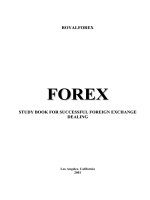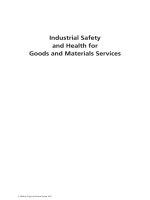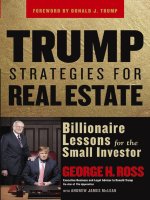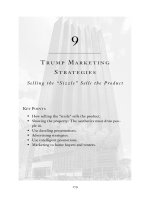Forex On-Line Manual For Successful Trading Chapter 1 doc
Bạn đang xem bản rút gọn của tài liệu. Xem và tải ngay bản đầy đủ của tài liệu tại đây (75.8 KB, 14 trang )
On-Line Manual
For Successful Trading
FOREX. On-line Manual For Successful Trading ii
CONTENTS
Chapter 1. Introduction 7
1.1. Foreign Exchange as a Financial Market 7
1.2. Foreign Exchange in a Historical Perspective 8
1.3. Main Stages of Recent Foreign Exchange Development 9
The Bretton Woods Accord 9
The International Monetary Fund 9
Free-Floating of Currencies 10
The European Monetary Union 11
The European Monetary Cooperation Fund 12
The Euro 12
1.4. Factors Caused Foreign Exchange Volume Growth 13
Interest Rate Volatility 13
Business Internationalization 13
Increasing of Corporate Interest 13
Increasing of Traders Sophistication 13
Developments in Telecommunications 14
Computer and Programming Development 14
FOREX. On-line Manual For Successful Trading iii
Chapter 2. Kinds Of Major Currencies
and Exchange Systems 15
2.1. Major Currencies 15
The U.S. Dollar 15
The Euro 15
The Japanese Yen 16
The British Pound 16
The Swiss Franc 16
2.2. Kinds of Exchange Systems 17
Trading with Brokers 17
Direct Dealing 18
Dealing Systems 18
Matching Systems 18
2.3. The Federal Reserve System of the USA and
Central Banks of the Other G-7 Countries 20
The Federal Reserve System of the USA 20
The Central Banks of the Other G-7 Countries 21
Chapter 3. Kinds of Foreign Exchange Market 23
3.1. Spot Market 23
3.2. Forward Market 26
3.3. Futures Market 27
3.4. Currency Options 28
Delta 30
Gamma 30
Vega 30
Theta 31
FOREX. On-line Manual For Successful Trading iv
Chapter 4. Fundamental Analysis 32
4.1. Economic Fundamentals 32
Theories of Exchange Rate Determination 32
Purchasing Power Parity 32
The PPP Relative Version 33
Theory of Elasticities
33
Modern Monetary Theories on Short-term Exchange
Rate Volatility 33
The Portfolio-Balance Approach 34
Synthesis of Traditional and Modern Monetary Views 34
4.2. Economic Indicators 35
The Gross National Product (GNP) 35
The Gross Domestic Product (GDP) 35
Consumption Spending 36
Investment Spending 36
Government Spending 36
Net Trade 36
Industrial Production 36
Capacity Utilization 36
Factory Orders 37
Durable Goods Orders 37
Business Inventories 37
Construction Indicators 37
Inflation Indicators 38
Producer Price Index (PPI) 39
Consumer Price Index (CPI) 39
Gross National Product Implicit Deflator 39
Gross Domestic Product Implicit Deflator 39
Commodity Research Bureau's Futures Index (CRB Index) 39
The “Journal of Commerce” Industrial Price Index (Joc) 40
Merchandise Trade Balance 40
Employment Indicators 40
Employment Cost Index (ECI) 41
Consumer Spending Indicators 41
Auto Sales 41
Leading Indicators 42
Personal Income 42
4.3. Financial and Sociopolitical Factors 43
The Role of Financial Factors 43
Political Events and Crises 44
FOREX. On-line Manual For Successful Trading v
Chapter 5. Technical Analysis 45
5.1. The Evolution and Fundamentals of Technical
Analysis Theory of Dow 45
Price 45
Volume and Open Interest 47
5.2. Types of Charts 49
Line Chart 49
Bar Chart 50
Candlestick Chart 51
5.3. Trends, Support and Resistance 53
Kinds of Trends 53
Percentage Retracement 55
The Trendline 55
Lines of Support and Resistance 57
5.4. Trend Reversal Patterns 59
Head-and-Shoulders 59
Signal Generated by the Head-and-shoulders Pattern 59
Inverse Head-and-Shoulders 61
Double Top 61
Signals Provided by the Double Top Formation 62
Double Bottom 63
Triple Top and Triple Bottom 63
The opposite is true for the triple bottom 64
Rounded Top and Bottom Formations 65
Diamond Formation 65
5.5. Trend Continuation Patterns 67
Flag Formation 67
Pennant Formation 67
Triangle Formation 70
Wedge Formation 75
Rectangle Formation 76
5.6. Gaps 78
Common Gaps 78
Breakaway Gaps 78
Runaway Gaps 79
Trading Signals for Runaway Gaps 79
Exhaustion Gaps 80
FOREX. On-line Manual For Successful Trading vi
5.7. Mathematical Trading Methods (Indicators) 81
Moving Averages 81
Trading Signals of Moving Averages 83
Oscillators 84
Stochastics 85
Moving Average Convergence-Divergence (MACD) 86
Momentum 87
The Relative Strength Index (RSI) 88
Rate of Change (ROC) 89
Larry Williams %R 90
Commodity Channel Index (CCI) 90
Bollinger Bands 93
The Parabolic System (SAR) 93
The directional movement index (DMI) 93
Chapter 6. The Fibonacci Analysis and
Elliott Wave Theory 95
6.1. The Fibonacci Analysis 95
6.2. The Elliott Wave 96
Basics of Wave Analysis 96
Impulse Waves—Variations 98
The Diagonal Triangles 100
Failures (Truncated Fifths) 102
Chapter 7. Foreign Exchange Risks 104
7.1. Exchange Rate Risk 104
7.2. Interest Rate Risk 106
7.3. Credit Risk 107
7.4. Country Risk 108
Glossary And Foreign Exchange Terms 109
Bibliography 141
FOREX. On-line Manual For Successful Trading 7
CHAPTER 1
Introduction
1.1. Foreign Exchange as a Financial Market
Currency exchange is very attractive for both the corporate and individual
traders who make money on the Forex - a special financial market assigned for
the foreign exchange. The following features make this market different in
compare to all other sectors of the world financial system:
• heightened sensibility to a large and continuously changing number of
factors;
• accessibility to all traders in the major currencies;
• guaranteed quantity and liquidity of the major currencies;
• increased consideration for several currencies, round-the clock
business hours which enable traders to deal after normal hours or during
national holidays in their country finding markets abroad open and
• extremely high efficiency relative to other financial markets.
This goal of this manual is to introduce beginning traders to all the
essential aspects of foreign exchange in a practical manner and to be a source of
best answers on the typical questions as why are currencies being traded, who are
the traders, what currencies do they trade, what makes rates move, what
instruments are used for the trade, how a currency behavior can be forecasted and
where the pertinent information may be obtained from. Mastering the content of
an appropriate section the user will be able to make his/her own decisions, test
them, and ultimately use recommended tools and approaches for his/her own
benefit.
FOREX. On-line Manual For Successful Trading 8
1.2. Foreign Exchange in a Historical Perspective
Currency trading has a long history and can be traced back to the ancient
Middle East and Middle Ages when foreign exchange started to take shape after
the international merchant bankers devised bills of exchange, which were
transferable third-party payments that allowed flexibility and growth in foreign
exchange dealings.
The modern foreign exchange market characterized by the consequent
periods of increased volatility and relative stability formed itself in the twentieth
century. By the mid-1930s London became to be the leading center for foreign
exchange and the British pound served as the
currency to trade and to keep as a
reserve currency. Because in the old times foreign exchange was traded on the
telex machines, or cable, the pound has generally the nickname “cable”. In 1930,
the Bank for International Settlements was established in Basel, Switzerland, to
oversee the financial efforts of the newly independent countries, emerged after
the World War I, and to provide monetary relief to countries experiencing
temporary balance of payments difficulties.
After the World War II, where the British economy was destroyed and the
United States was the only country unscarred by war, U.S. dollar became the
prominent currency of the entire globe. Nowadays, currencies all over the world
are generally quoted against the U.S. dollar.
FOREX. On-line Manual For Successful Trading 9
1.3. Main Stages of Recent Foreign Exchange
Development
The main phases of the further development of the Forex in modern
times were:
• signing of the Bretton Woods Accord;
• constitution of the international monetary fund (IMF);
• emergency of the free-floating foreign exchange markets;
• creation of currency reserves;
• constitution of the European Monetary Union and the European
Monetary Cooperation Fund;
• introduction of the Euro as a currency.
The Bretton Woods Accord was signed in July 1944 by the United States,
Great Britain, and France which agreed to make the currency market stable,
particularly due to governmental controls on currency values. In order to
implement it, two major goals were: emphasized: to provide the pegging
(backing of prices) of currencies and to organize the International Monetary Fund
(IMF).
In accordance to the Bretton Woods Accord, the major trading currencies
were pegged to the U.S. dollar in the sense that they were allowed to fluctuate
only one percent on either side of that rate. When a currency exceeded this
range, marked by intervention points, the central bank in charge had to buy it or
sell it, and thus bring it back into range. In turn, the U.S. dollar was pegged to
gold at $35 per ounce. Thus, the U.S. dollar became the world's reserve currency.
The purpose of IMF is to consult with one another to maintain a stable
system of buying and selling the currencies, so that payments in foreign
money can take place between countries smoothly and timely.
The IMF lends money to members who have trouble meeting financial
obligations to other members, on the condition that they undertake economic
reforms to eliminate these difficulties for their own good and the good of the
entire membership. In total the main tasks of the IMF are:
• to promote international cooperation by providing the means for
members to consult and collaborate on international monetary issues;
• to facilitate the growth of international trade and thus contribute to
high levels of employment and real income among member nations;
• to promote stability of exchange rates and orderly exchange
agreements, and [to] discourage competitive currency depreciation;
• to foster a multilateral system of international payments, and to seek
the elimination of exchange restrictions that hinder the growth of world trade;
• to make financial resources available to members, on a temporary
basis and with adequate safeguards, to permit them to correct payments
imbalances without resorting to measures destructive to national and international
prosperity.
FOREX. On-line Manual For Successful Trading 10
To execute these goals the IMF uses such instruments as Reserve tranche
which allows a member to draw on its own reserve asset quota at the time of
payment, Credit tranche drawings and stand-by arrangements are the standard
form of IMF loans, the compensatory financing facility extends financial help to
countries with temporary problems generated by reductions in export revenues,
the buffer stock financing facility which is geared toward assisting the stocking
up on primary commodities in order to ensure price stability in a specific
commodity and the extended facility designed to assist members with financial
problems in amounts or for periods exceeding the scope of the other facilities.
Since 1978 free-floating of currencies were officially mandated by the
International Monetary Fund. That is the currency may be traded by anybody and
its value is a function of the current supply and demand forces in the market, and
there are no specific intervention points that have to be observed. Of course, the
Federal Reserve Bank irregularly intervenes to change the value of the U.S.
dollar, but no specific levels are ever imposed. Naturally, free-floating
currencies are in the heaviest trading demand. Free-floating is not the sine qua
non condition for trading. Liquidity is also an indispensable condition.
A tool for people and corporations to protect investments in times of
economic or political instability is currency reserves for international
transactions. Immediately after the World War II the reserve currency worldwide
was the U.S. dollar. Currently there are other reserve currencies: the euro and
the Japanese yen. The portfolio of reserve currencies may change depending on
specific international conditions, for instance it may include the Swiss franc.
The creation of the European Monetary Union was the result of a long and
continuous series of post-World War II efforts aimed at creating closer economic
cooperation among the capitalist European countries. The European Community
(EC) commission's officially stated goals were to improve the inter-European
economic cooperation, create a regional area of monetary stability, and act as "a
pole of stability in world currency markets."
The first steps in this rebuilding were taken in 1950, when the European
Payment Union was instituted to facilitate the inter-European settlements of
international trade transactions. The purpose of the community was to promote
inter-European trade in general, and to eliminate restrictions on the trade of coal
and raw steel in particular.
In 1957, the Treaty of Rome established the European Economic
Community, with the same signatories as the European Coal and Steel
Community. The stated goal of the European Economic Community was to
eliminate customs duties and any barriers against the transit of capital, services,
and people among the member nations. The EC also started to raise common
tariff barriers against outsiders.
FOREX. On-line Manual For Successful Trading 11
The European Community consists of four executive and legislative bodies:
1. The European Commission. The executive body in charge of making
and observing the enforcement of the policies. Since it lacks an enforcement
arm, the commission must rely on individual governments to enforce the policies.
There are 23 departments, such as foreign affairs, competition policy, and
agriculture. Each country selects its own representatives for four-year terms. The
commission is based in Brussels and consists of 17 members.
2. The Council of Ministers. Makes the major policy decisions. It is
composed of ministers from the 12 member nations. The presidency is held for
six months by each of the members, in alphabetical order. The meetings take
place in Brussels or in the capital of the nation holding the presidency.
3. The European Parliament. Reviews and amends legislative proposals
and has the power to adopt or reject budget proposals. It consists of 518
elected members. It is based in Luxembourg, but the sessions take place in
Strasbourg or Brussels.
4. The European Court of Justice. Settles disputes between the EC and
the member nations. It consists of 13 members and is based in Luxembourg.
In 1963, the French-West German Treaty of Cooperation was signed. This
pact was designed not only to end centuries of bellicose rivalry, but also to
settle the postwar reconciliation between two major foes. The treat stipulated
that West Germany would lead economically through the cold war, and France,
the former diplomatic powerhouse, would provide the political leadership. The
premise of this treaty was obviously correct in an environment defined by a
foreseeable long-term continuing cold war and a divided Germany. Later in this
chapter, we discuss the implications for the modern era of this enormously
expensive pact.
A conference of national leaders in 1969 set the objective of establishing a
monetary union within the European Community. This goal was supposed to be
implemented by 1980, when a common currency was planned to be used in
Europe. The reasons for the proposed common currency unit were to stimulate
inter-European trade and to weld together the individual member economies in
order to compete successfully with the economies of the United States and
Japan.
In 1978, the nine members of the European Community ratified a new plan
for stability—the European Monetary System. The new system was practically
established in 1979. Seven countries were then full members—West
Germany, France, the Netherlands, Belgium, Luxembourg, Denmark, and
Ireland. Great Britain did not participate in all of the arrangements and Italy
joined under special conditions. Greece joined in 1981, Spain and Portugal in
1986. Great Britain joined the Exchange Rate Mechanism in 1990.
FOREX. On-line Manual For Successful Trading 12
The European Monetary Cooperation Fund was established to manage
the EMS' credit arrangements. In order to increase the acceptance of the
ECU, countries that hold more ECU deposits, or accept as loan repayment more
than their share of ECU, receive interest on the excess ECU deposits, and vice
versa. The interest rate is the weighted average of all the EMS members'
discount rates.
In 1998 the Euro was introduced as an all-European currency. Here are
the official locking rates of the 11 participating European currencies in the
euro (EUR). The rates were proposed by the EU Commission and approved by
EU finance ministers on December 31, 1998, ahead of the launch of the euro
at midnight, January 1, 1999.
The real starting date was Monday, January 4, 1999. The conversion
rates are:
1 EUR = 40.3399 BEF 1 EUR = 1.95583 DEM
1 EUR = 166.386 ESP 1 EUR = 6.55957 FRF
1 EUR = 0.787564 IEP 1 EUR = 1936.27 ITL
1 EUR = 40.3399 LUF 1 EUR = 2.20371 NLG
1 EUR = 13.7603 ATS 1 EUR = 200.482 PTE
1 EUR = 5.94573 FIM
The euro bills are issued in denominations of 5, 10, 20, 50, 100, 200,
and 500 euros. Coins are issued in denominations of 1 and 2 euros, and 50,
20,10, 5, 2, and 1 cent.
FOREX. On-line Manual For Successful Trading 13
1.4. Factors Caused Foreign Exchange Volume Growth
Foreign exchange trading is generally conducted in a decentralized manner,
with the exceptions of currency futures and options. Foreign exchange has
experienced spectacular growth in volume ever since currencies were allowed to
float freely against each other. While the daily turnover in 1977 was U.S. $5
billion, it increased to U.S. $600 billion in 1987, reached the U.S. $1 trillion mark
in September 1992, and stabilized at around $1,5 trillion by the year 2000.
Main factors influence on this spectacular growth in volume are indicated
below.
For foreign exchange, currency volatility is a prime factor in the growth
of volume. In fact, volatility is a sine qua non condition for trading. The only
instruments that may be profitable under conditions of low volatility are
currency options.
Interest Rate Volatility
Economic internationalization generated a significant impact on interest
rates as well. Economics became much more interrelated and that exacerbated the
need to change interest rates faster. Interest rates are generally changed in order
to adjust the growth in the economy, and interest rate differentials have a
substantial impact on exchange rates.
Business Internationalization
In recent decades the business world the competition has intensified,
triggering a worldwide hunt for more markets and cheaper raw materials and
labor. The pace of economic internationalization picked up even more in the
1990s, due to the fall of Communism in Europe and to up-and-down economic
and financial development in both Southeast Asia and South America. These
changes have been positive toward foreign exchange, since more transactional
layers were added.
Increasing of Corporate Interest
A successful performance of a product or service overseas may be pulled
down from the profit point of view by adverse foreign exchange conditions and
vice versa. An accurate handling of the foreign exchange may enhance the overall
international performance of a product or service. Proper handling of foreign
exchange generally adds substantially to the rate of return. Therefore, interest
in foreign exchange has increased in the past decade. Many corporations are
using currencies not only for hedging, but also for capitalizing on opportunities that
exist solely in the currency markets.
Increasing of Traders Sophistication
Advances in technology, computer software, and telecommunications and
increased experience have increased the level of traders' sophistication. This
FOREX. On-line Manual For Successful Trading 14
enhanced traders' confidence in their ability to both generate profits and
properly handle the exchange risks. Therefore, trading sophistication led toward
volume increase.
Developments in Telecommunications
The introduction of automated dealing systems in the 1980s, of matching
systems in the early 1990s, and of Internet trading in the late 1990s completely
altered the way foreign exchange was conducted. The dealing systems are on-
line computer systems that link banks on a one-to-one basis, while matching
systems are electronic brokers. They are reliable and much faster, allowing traders
to conduct more simultaneous trades. They are also safer, as traders are able to
see the deals that they execute. The dealing systems had a major role in
expanding the foreign exchange business due to their reliability, speed, and
safety.
Computer and Programming development
Computers play a significant role at many stages of conducting foreign
exchange. In addition to the dealing systems, matching systems simultaneously
connect all traders around the world, electronically duplicating the brokers'
market. The new office systems provide full accounting coverage, ticket writing,
back office processing, and risk management implementation at a fraction of their
previous cost. Advanced software makes it possible to generate all types of
charts, augment them with sophisticated technical studies, and put them at
traders' fingertips on a continuous basis at a rather limited cost.









